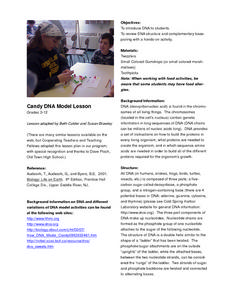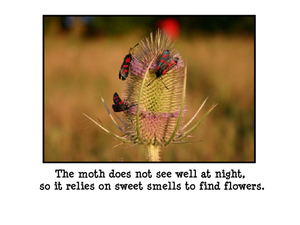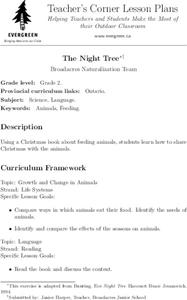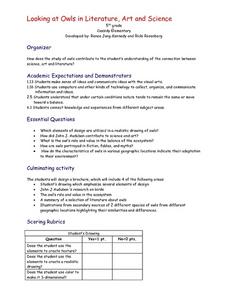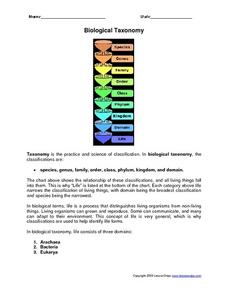Curated OER
Predator-Prey Relationships
Young scholars understand ecological systems. They provide experiences to assist citizens to increase their sensitivity and stewardship for the environment.
Curated OER
Candy DNA Model Lesson
Students explore DNA structure using materials such as Twizzlers, small colored gumdrops and/or toothpicks.
Curated OER
Rain Forest Animals
Pupils create a book about animal species found only in the Amazon rain forest. They find one species to represent each letter of the alphabet, and write each name on a different piece of paper. They illustrate each page with an original...
Curated OER
Mary, Mary, Quite Contrary
First graders use simple vegetable cut out and colored paper flower peddles to make simple patterns. They start out with a simple 2-element patterns around the theme of a daisy and increase in difficulty.
Curated OER
Predator-Prey Relationships
Students explore the interrelatedness of predators and prey in four different activities. They simulate an aquatic insect, fish, and osprey food chain during a poker chip game, play an M&M game to simulate the relationship between...
Curated OER
Sea Turtle Savvy
Students explore sea turtles. They create paper plate sea turtles and brainstorm other organisms that live in the sea turtle's habitat. They role-play scenes from a nonfiction book, A Baby Sea Turtle's Journey. They play a game...
Curated OER
Humane Science Projects
In this science learning exercise, students examine the list of possible science projects. They look for the characteristics that set apart these ideas as humane.
Curated OER
Explorations Through Time
In this earth history worksheet, students visit a website and complete 15 fill in the blank and 8 short answer questions based on what they read. Topics include biodiversity, animal kingdoms, evolution, fossils, and extinction.
Curated OER
Wild Animal Science
Students discover how environmental factors impact the survival of a population. In this landscape design lesson, students create a new animal and discuss the relationship between the animal and its environment before creating a habitat...
Curated OER
Human Inventions with Animal Features
In this animal features worksheet, students match different animal features with the human invention that is similar. Students match 9 inventions and then complete 3 short answer questions.
Curated OER
Smarty Plants
Young scholars examine plants and pollinators. In this plant biology lesson, students read The Power of Pollinators and identify the parts of the plant and the pollinators. Young scholars design their own imaginary plants.
Curated OER
Winter Survival
Learners examine what animals need in order to survive. In this investigative lesson students play a "role" of an animal in winter.
Curated OER
The Night Tree
Second graders explore the book, Night Tree, by Eve Bunting. They read and discuss the story, identify what the tree did for the animals, create a food chain for animals to hang on a tree, and decorate a tree at school.
Curated OER
What's For Dinner?
Learners explore the food chain. They brainstorm and create a consumer-consumed food chains using magazine pictures and research materials. Students identify consumer-consumed relationships.
Curated OER
Environment: Understanding Climate Impacts
Students investigate the potential environmental consequences of climate change. They conduct Internet research to discover how climate change may impact certain species of animals and present their findings in a poster or skit. Students...
Curated OER
Looking at Owls in Literature, Art, and Science
Fifth graders investigate the characteristics of owls through various science and art activities. They analyze drawings by J.J. Audubon and complete a Venn diagram comparing the similarities and differences of different kinds of owls,...
Curated OER
Can You Beat Jet Lag?
Learners examine the health condition of jet lag. Using mealworms, they test the effect of light on the development of them into adults. They answer discussion questions and examine the relationship of age and one's activity level.
Curated OER
VERTEBRATES
Seventh graders describe the main characteristics of warm-blooded vertebrate animals. They compare and contrast the two different groups of warm-blooded vertebrate animals by looking at external, reproductive, and growth characteristics.
Curated OER
Fishes
In this fish worksheet, students will review the characteristics of fish by comparing the jaws, skeleton, and fertilization of each fish class. Then students will use a phylogenetic tree to compare the groups of fish to ancestral...
Curated OER
Reproduction
In this reproduction worksheet, students review the processes involved with sexual reproduction in animals and pollination in plants. This worksheet has 6 fill in the blank, 5 true or false, and 9 short answer questions.
Curated OER
Biological Taxonomy
For this biology worksheet, students read about biological taxonomy. They then use the information they learned to answer the 13 questions on the worksheet. The answers are on the last page of the packet.
Curated OER
Word Search Game Worksheet 11
In this word puzzle worksheet, students analyze a grid of letters to find 6 words to circle. Students use the clues to help. There is no theme.
Curated OER
Owls - Reading Comprehension
In this science reading comprehension activity, students read a selection that describes the characteristics and habits of owls. They answer 7 multiple choice questions based on the reading.
Curated OER
The Clever Stick
Students read the book The Clever Stick and answer discussion questions about it. For this reading lesson, students read the given book, and participate in answering questions based on the book. There are also writing, drawing, and...
Other popular searches
- Adaptations of Bird Beaks
- Science Bird Adaptations
- Animal and Bird Adaptations
- Baby Bird Adaptations
- Bird Adaptations Behavior
- Bird Adaptations Behaviour
- Bird Adaptations Galapagos
- Adaptations Bird Beak



